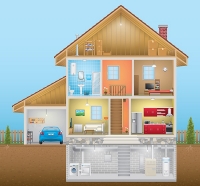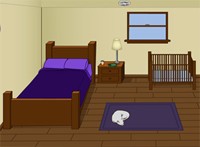Healthy Homes - Bedroom
Health and safety tips
- Maintain smoke alarms and carbon monoxide detectors.
- Wash sheets and blankets in hot water to reduce asthma triggers.
- Use mattress and pillow covers.
- Vacuum often.
Green tips
- Install energy-efficient windows to reduce energy costs.
- Open curtains and blinds during the day to allow for natural sunlight. Light colored or loose-weave curtains allow sunlight into the room while maintaining privacy.
Carbon monoxide safety
All people and animals are at risk for carbon monoxide poisoning. Certain groups, such as unborn babies, infants, and people with chronic heart disease, anemia, or respiratory problems, are more easily affected by carbon monoxide poisoning.
Lead-based paint
In homes built prior to 1978, there is an increased risk of having lead-based paint. If small children ingest lead-based paint chips or dust during hand-to-mouth behavior, they could be exposed. If you are remodeling an old home, the risk could be even higher. Lead check test kits are readily available from home and hardware stores. For more information about preventing childhood exposure to lead, visit the Tennessee Childhood Lead Poisoning Prevention Program or our general webpage about lead.
Asthma
People spend a lot of time in their bedrooms. For people with asthma, breathing and sleeping may be difficult if there are asthma triggers capable of causing an asthma attack in the bedroom. Here are few different asthma triggers that may be present in a bedroom and how to avoid them.
Asthma can be triggered by the smoke from the burning end of a cigarette, pipe or cigar, or by secondhand smoke from a smoker. Do not smoke in bedrooms. Dust mites are tiny bugs too small to be seen but present in every home. They live in mattresses, pillows, carpets, fabric-covered furniture, bedding, clothes and stuffed toys. It is important to use pillow cases and wash bed linens on a regular basis to control dust mites. Pet skin flakes, urine and saliva can be asthma triggers. Keep pets off of the beds of asthmatics.
House dust contains asthma triggers. Remove dust often with a damp cloth. Vacuum carpet and fabric-covered furniture to reduce dust buildup. Bedrooms that are kept clean will help to control asthma triggers.
What about bed bugs?
Bed bugs are not as common as other pests. The adult bed bug is about a ¼ inch long and reddish brown. Young nymph bed bugs are smaller and light-colored. Bed bugs are flat, allowing them fit in small cracks and crevices. Bed bugs usually bite at night.
Bed bugs are often accidentally transported in luggage, clothing, beds, furniture and other items. Be cautious with used or rented beds, bedding, furniture and other items that may harbor bed bugs. Inspect them before bringing them into your home. It can be helpful to use mattress cases on your bed. Avoid having clutter under or around your bed. If you have unexpected bug bites, inspect your bed and bedding looking for the signs of the small brown bugs. If you have severe bites or an allergic reaction, contact your doctor. To read more about bed bugs click on the EPA’s Bed Bug Information webpage . If you believe that you have bed bugs in your home, consider hiring a professional exterminator who has successfully treated for bed bug problems. Be careful using pesiticides indoor to try to control bed bugs as misuse of pesticides can harm your health.

Additional resources
Centers for Disease Control and Prevention (CDC)
Carbon Monoxide Poisoning
www.cdc.gov/co/faqs.htm
Smoking and Tobacco use
www.cdc.gov/tobacco
Asthma
www.cdc.gov/asthma/faqs.htm
CDC's Childhood Lead Poisoning Prevention Program
www.cdc.gov/nceh/lead/tips.htm
U.S. Department of Housing and Urban Development (HUD)
Help Yourself to a Healthy Home
nhl.gov/offices/lead/library/hhi/HYHH_Booklet.pdf
U.S. Department of Energy (DOE)
Energy Savers: Energy Efficient Windows
www.energy.gov/energysaver/design/windows-doors-and-skylights/update-or-replace-windows
Additional resources
American Red Cross
Home Fire Prevention
www.redcross.org/get-help/how-to-prepare-for-emergencies/types-of-emergencies/fire.html
